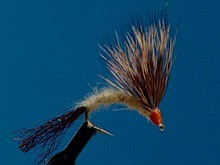
On The Fly
"Fly tying is a school from which we never graduate"
TYING NEWS
The Southern Oregon Fly Tyers invite you to attend their next meeting, Tuesday, February 9,
2010, at 6:30 PM, at the Madrone Hill Mobile Home Park community building near Gold Hill. Bring a
friend, come early so you don't miss anything, and stay late. Tiers need not be experienced, and those with
all levels of skill are welcome. Each meeting a member is encouraged to demonstrate a new or different
skill, from simple to difficult. For more information, call Dan Kellogg at 773-4724.
Dave Roberts was our featured tyer at the January meeting and he demonstrated some very
useful tips that can be applied to all our dry fly tying. The use of various feathers for wings and winging
techniques was especially appreciated. Thanks, Dave.
DIRECTIONS: Take Gold Hill Exit #40, off of I-5 and go west, toward Jacksonville, 1.3
miles, until you reach the brick entrance way to the Madrone Hill Mobile Home Park on the right. You’ll
pass a golf course parking lot on Your left shortly after leaving the freeway. After you turn right into the
mobile home park, proceed to the community building which is located about 100 yards ahead on the left. The
address is 8401 Old Stage Rd. Please park your vehicle on the bare dirt in the parking lot to avoid the
wooden septic covers in the grass.
PATTERN OF THE MONTH - March Brown Deer Hair Emerger

Hook: Daiichi 1130, heavy wide-gape scud hook.
Thread: Rusty Orange, 8-0.
Body: Pale yellowish tan beaver.
Tail: Brown Z-lon.
Wing: Coastal Deer hair.
Tying Instructions
Step 1: Mash the barb and mount the hook in the vise. Start the tying thread one eye width behind the eye
and wrap a thread base back to a point halfway down the bend.
Step 2: Select a small bunch of Z-lon fibers and measure them to be one hook-length. Tie the fibers on top
of the hook shank halfway down the bend and bind down the butts along the top of the shank back to the
thread tie-in point. Trim the butts.
Step 3: Dub the thread using a dubbing loop and wind forward forming a tapered body. End the body about 1/4
shank length back from the eye.
Step 4: Select a bunch of deer hair and measure to one hook length. Holding the bunch firmly between your
thumb and forefinger, tie down the hair on top of the hook shank with firm enough wraps to flair slightly.
Trim the butts just behind the eye at an angle.
Step 5: Bind the butts of the deer hair with touching thread wraps to form a tapered head. Whip finish and
cement.
March Brown mayflies are the year’s first hatch of large size insects and can produce
excellent fishing. The duns range in size from 10-14, have tan underbellies with mottled brown or gray
wings. While most anglers concentrate on the adults, there are many other opportunities. In the early part
of March, when the weather is still cool, emerger fishing can be deadly. There are often many cripples that
do not get out of the case and literally hundreds of others that are just slow in doing so. There is
something about the “helpless” nature of this pattern that makes it irresistible to trout.
TYING TIPS
The curved hook gives the appearance of a struggling emerger. The Z-lon tail imitates the
trailing shuck of a cripple. It should be somewhat sparse. By using a dubbing loop with fine dry fly dubbing
you get a tighter, trim body, more like the natural. Coastal deer hair is less hollow than other types, and
therefore less apt to flare too much. The wing should angle back towards the tail at about 45 degrees. The
March Brown Deer Hair Emerger is a simple tie, using only three materials. By changing color and size it
can be used for any hatch you encounter. So tie some up, give them a test flight, and let me know how you do.
Tie One On,
Dan Kellogg (you can contact me at FLYGUY@EZNORTHWEST.COM)